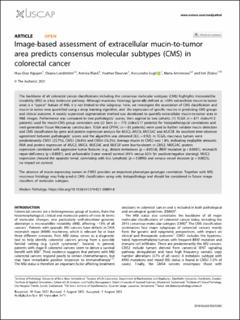Please use this identifier to cite or link to this item:
https://doi.org/10.21256/zhaw-23798Full metadata record
| DC Field | Value | Language |
|---|---|---|
| dc.contributor.author | Nguyen, Huu-Giao | - |
| dc.contributor.author | Lundström, Oxana | - |
| dc.contributor.author | Blank, Annika | - |
| dc.contributor.author | Dawson, Heather | - |
| dc.contributor.author | Lugli, Alessandro | - |
| dc.contributor.author | Anisimova, Maria | - |
| dc.contributor.author | Zlobec, Inti | - |
| dc.date.accessioned | 2021-12-20T10:30:36Z | - |
| dc.date.available | 2021-12-20T10:30:36Z | - |
| dc.date.issued | 2021-09-02 | - |
| dc.identifier.issn | 0893-3952 | de_CH |
| dc.identifier.issn | 1530-0285 | de_CH |
| dc.identifier.uri | https://digitalcollection.zhaw.ch/handle/11475/23798 | - |
| dc.description.abstract | The backbone of all colorectal cancer classifications including the consensus molecular subtypes (CMS) highlights microsatellite instability (MSI) as a key molecular pathway. Although mucinous histology (generally defined as >50% extracellular mucin-to-tumor area) is a "typical" feature of MSI, it is not limited to this subgroup. Here, we investigate the association of CMS classification and mucin-to-tumor area quantified using a deep learning algorithm, and the expression of specific mucins in predicting CMS groups and clinical outcome. A weakly supervised segmentation method was developed to quantify extracellular mucin-to-tumor area in H&E images. Performance was compared to two pathologists' scores, then applied to two cohorts: (1) TCGA (n = 871 slides/412 patients) used for mucin-CMS group correlation and (2) Bern (n = 775 slides/517 patients) for histopathological correlations and next-generation Tissue Microarray construction. TCGA and CPTAC (n = 85 patients) were used to further validate mucin detection and CMS classification by gene and protein expression analysis for MUC2, MUC4, MUC5AC and MUC5B. An excellent inter-observer agreement between pathologists' scores and the algorithm was obtained (ICC = 0.92). In TCGA, mucinous tumors were predominantly CMS1 (25.7%), CMS3 (24.6%) and CMS4 (16.2%). Average mucin in CMS2 was 1.8%, indicating negligible amounts. RNA and protein expression of MUC2, MUC4, MUC5AC and MUC5B were low-to-absent in CMS2. MUC5AC protein expression correlated with aggressive tumor features (e.g., distant metastases (p = 0.0334), BRAF mutation (p < 0.0001), mismatch repair-deficiency (p < 0.0001), and unfavorable 5-year overall survival (44% versus 65% for positive/negative staining). MUC2 expression showed the opposite trend, correlating with less lymphatic (p = 0.0096) and venous vessel invasion (p = 0.0023), no impact on survival.The absence of mucin-expressing tumors in CMS2 provides an important phenotype-genotype correlation. Together with MSI, mucinous histology may help predict CMS classification using only histopathology and should be considered in future image classifiers of molecular subtypes. | de_CH |
| dc.language.iso | en | de_CH |
| dc.publisher | Nature Publishing Group | de_CH |
| dc.relation.ispartof | Modern Pathology | de_CH |
| dc.rights | https://creativecommons.org/licenses/by/4.0/ | de_CH |
| dc.subject.ddc | 572: Biochemie | de_CH |
| dc.title | Image-based assessment of extracellular mucin-to-tumor area predicts consensus molecular subtypes (CMS) in colorectal cancer | de_CH |
| dc.type | Beitrag in wissenschaftlicher Zeitschrift | de_CH |
| dcterms.type | Text | de_CH |
| zhaw.departement | Life Sciences und Facility Management | de_CH |
| zhaw.organisationalunit | Institut für Computational Life Sciences (ICLS) | de_CH |
| dc.identifier.doi | 10.1038/s41379-021-00894-8 | de_CH |
| dc.identifier.doi | 10.21256/zhaw-23798 | - |
| dc.identifier.pmid | 34475526 | de_CH |
| zhaw.funding.eu | No | de_CH |
| zhaw.originated.zhaw | Yes | de_CH |
| zhaw.pages.end | 248 | de_CH |
| zhaw.pages.start | 240 | de_CH |
| zhaw.publication.status | publishedVersion | de_CH |
| zhaw.volume | 35 | de_CH |
| zhaw.publication.review | Peer review (Publikation) | de_CH |
| zhaw.funding.snf | 193832 | de_CH |
| zhaw.webfeed | Computational Genomics | de_CH |
| zhaw.funding.zhaw | Trans-omic approach to colorectal cancer: an integrative computational and clinical perspective | de_CH |
| zhaw.author.additional | No | de_CH |
| zhaw.display.portrait | Yes | de_CH |
| Appears in collections: | Publikationen Life Sciences und Facility Management | |
Files in This Item:
| File | Description | Size | Format | |
|---|---|---|---|---|
| 2021_Nguyen-etal_CMS-prediction-colorectal-cancer.pdf | 2.24 MB | Adobe PDF |  View/Open |
Show simple item record
Nguyen, H.-G., Lundström, O., Blank, A., Dawson, H., Lugli, A., Anisimova, M., & Zlobec, I. (2021). Image-based assessment of extracellular mucin-to-tumor area predicts consensus molecular subtypes (CMS) in colorectal cancer. Modern Pathology, 35, 240–248. https://doi.org/10.1038/s41379-021-00894-8
Nguyen, H.-G. et al. (2021) ‘Image-based assessment of extracellular mucin-to-tumor area predicts consensus molecular subtypes (CMS) in colorectal cancer’, Modern Pathology, 35, pp. 240–248. Available at: https://doi.org/10.1038/s41379-021-00894-8.
H.-G. Nguyen et al., “Image-based assessment of extracellular mucin-to-tumor area predicts consensus molecular subtypes (CMS) in colorectal cancer,” Modern Pathology, vol. 35, pp. 240–248, Sep. 2021, doi: 10.1038/s41379-021-00894-8.
NGUYEN, Huu-Giao, Oxana LUNDSTRÖM, Annika BLANK, Heather DAWSON, Alessandro LUGLI, Maria ANISIMOVA und Inti ZLOBEC, 2021. Image-based assessment of extracellular mucin-to-tumor area predicts consensus molecular subtypes (CMS) in colorectal cancer. Modern Pathology. 2 September 2021. Bd. 35, S. 240–248. DOI 10.1038/s41379-021-00894-8
Nguyen, Huu-Giao, Oxana Lundström, Annika Blank, Heather Dawson, Alessandro Lugli, Maria Anisimova, and Inti Zlobec. 2021. “Image-Based Assessment of Extracellular Mucin-to-Tumor Area Predicts Consensus Molecular Subtypes (CMS) in Colorectal Cancer.” Modern Pathology 35 (September): 240–48. https://doi.org/10.1038/s41379-021-00894-8.
Nguyen, Huu-Giao, et al. “Image-Based Assessment of Extracellular Mucin-to-Tumor Area Predicts Consensus Molecular Subtypes (CMS) in Colorectal Cancer.” Modern Pathology, vol. 35, Sept. 2021, pp. 240–48, https://doi.org/10.1038/s41379-021-00894-8.
Items in DSpace are protected by copyright, with all rights reserved, unless otherwise indicated.